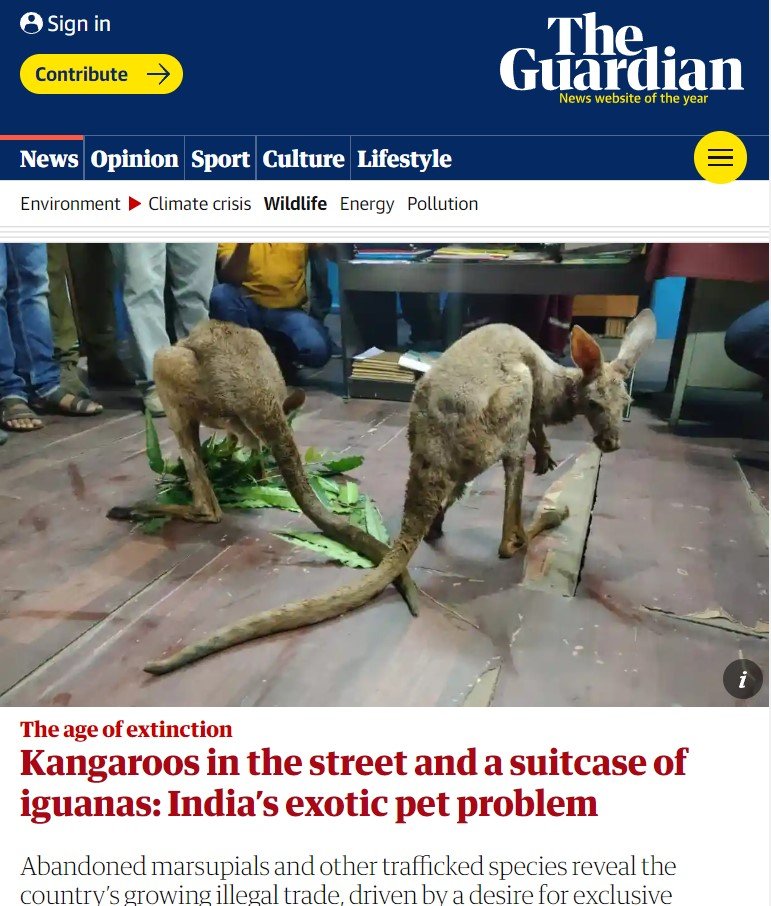Abandoned marsupials and other trafficked species reveal the country’s growing illegal trade, driven by a desire for exclusive and costly status symbols

Kalpana SunderTue 7 Jun 2022 07.45 BST
From the red-eared slider turtle, cockatoo and falcon to the yellow-cheeked gibbon, capuchin monkey and orangutan, nothing is too much for those demanding unusual pets in India. But it was the sight of three kangaroos wandering the streets of West Bengal’s Jalpaiguri district in April that brought home the extent of the country’s exotic pet trade.
The malnourished kangaroos were intercepted after tipoffs from local residents. One of the rescued marsupials later died, while the remaining two are recovering and will be rehomed at a nearby zoo.

A senior forestry official told the Indian Express at the time: “We are surprised as to who brought these kangaroos here, and how. We suspect they were being smuggled to Nepal.”
The kangaroos were the latest in a series of trafficking cases of exotic species into India in the last few years: in April, five exotic monkeys and a wallaby were rescued in Assam, shortly after five siamang gibbons were found in the same state; 30 exotic birds and a red-eared guenon, native to Africa and listed as vulnerable on the International Union for Conservation of Nature (IUCN) red list, were intercepted at the Mizoram-Assam border in January 2021; in July 2020, also in Assam, a kangaroo, blue macaws, capuchin monkeys and Aldabra giant tortoises were rescued; and in October 2019, the customs department at Tiruchirappalli international airport in Tamil Nadu seized a suitcase packed with exotic reptiles, including iguanas.
According to a report by Traffic India, more than 70,000 native and exotic wild animals were seized at India’s airports between 2011 and 2020, with many featured on the IUCN red list and the Convention on International Trade in Endangered Species of Wild Fauna and Flora (Cites) appendices. The most common non-native species seized was the red-eared slider turtle, followed by the Chinese pond turtle.
The growing number and diversity of exotic species being smuggled into India has surprised everyone
Dr Saket Badola, Traffic India
The exotic animals are sold in markets and pet shops across India, as well as online. A two-year study found as many as 84 exotic reptile species were traded in India between 2018 and 2020.
“India is both a source and destination of illegal wildlife trade, and is at times a transit route, too,” says Jose Louies, head of wildlife crime control at the Wildlife Trust of India. “The exotic animal trade into India is driven by the demand of people who would like to own something exclusive and costly, as a style or status symbol, with disregard for their natural habitat. Most of the animals end up in a zoo, as the country of origin may not repatriate them.”

Dr Saket Badola, head of Traffic India, says: “The number and diversity of exotic species being smuggled into India has surprised everyone. We attribute it to the growing number of Indians with disposable incomes and the influence of social media, where people are exposed to exotic species being kept as pets around the world.”
Traffickers are exploiting a loophole in India’s 1978 Wildlife Protection Act, which protects native species but does not cover imported or exotic species. Trade in any exotic species listed by Cites is allowed only with import and export licences, certificates and permissions from appropriate authorities. However, the animal may be freely traded once it has entered India.
In June 2020, India’s ministry of environment, forest and climate change offered amnesty to Indians in possession of exotic species without documentation. More than 32,000 people declared animals, including kangaroos, iguanas and lemurs, according to a report by IndiaSpend, a data-driven journalism initiative.
“The concerns with this illegal trade are manifold,” says Badola. “Besides threatening the species in their natural habitat, they can spread zoonotic diseases as they travel across the globe, carrying pathogens and viruses not seen in this part of the world. Lots of invasive imported species can threaten the local species, too.
“Most of the illegal shipments come via air, as many species are very expensive. To minimise losses they are hidden in plastic boxes and bottles, in hand baggage, checked baggage or air cargo. Others that come by land are trafficked through the porous borders with Myanmar, Bangladesh and Nepal.”
Many animals that are seized are repatriated, but if their country of origin is unclear, they are quarantined then sent to local zoos or wildlife parks.
“The major concern is that invasive species that reach the country as part of this international trade could impact our biodiversity,” says Louies.
Traffic is working with customs officers at airports, training staff to be aware of illegal contraband beyond gold or narcotics. They have also developed an online course about the wildlife trade, including relevant laws, red flags to watch out for at airports and how to handle seizures of dangerous species.
Campaigners hope that the wildlife (protection) amendment bill, 2021 will be passed by the Indian parliament this year, increasing the number of species protected under the law.
“The proposed amendment empowers the government to regulate or prohibit the import, trade, possession or proliferation of invasive alien species which pose a threat to the wildlife or habitat,” says Debadityo Sinha of the Vidhi Centre for Legal Policy.
But, he adds: “The proposed definition of ‘invasive alien species’ is limited to only species which are not native to India. Ideally, this definition should include any species not native to the geographical range. We have many examples which indicate that species from one geographic area can become invasive and pose a threat to local biodiversity when introduced to other geographic areas within the country.”
Original Link- https://www.theguardian.com/environment/2022/jun/07/kangaroos-in-the-street-and-a-suitcase-of-iguanas-india-exotic-pet-problem-aoe


